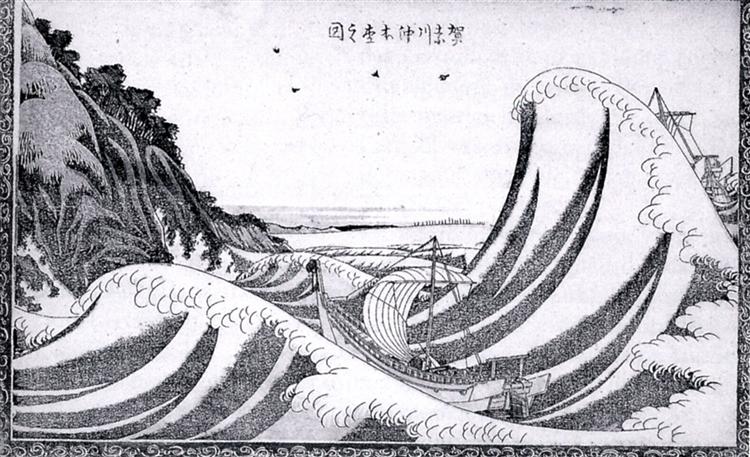Beskrivelse
Katsushika Hokusai’s Homoku View stands as a notable example of the ukiyo-e style, a form of woodblock printmaking that flourished in Japan between the 17th and 19th centuries. One of the most celebrated ukiyo-e artists, Hokusai is known for his ability to capture the beauty of nature and everyday life through vibrant, dynamic compositions. In Homoku View, he creates an atmosphere that transcends simplicity, inviting the viewer into a sensory experience that connects with the vastness of the natural environment.
The composition of the painting is characterised by a balanced arrangement that allows for easy visual reading. Like many of his works, Hokusai uses a soft but remarkably expressive colour palette. The blue tones of the sky and sea are combined with shades of grey and white, creating an attractive and evocative contrast. This choice of colours not only reflects the harmony of the landscape, but also suggests the cycles of nature, which is at the heart of the Japanese philosophy of respect for the Earth.
One of the most fascinating aspects of *Vista Homoku* is its interpretation of space. Although the work does not contain human figures in the foreground, it suggests the presence of man through the representation of boats on the horizon. These marine elements, although small in comparison to the majesty of the natural environment, allow the viewer to connect with the scale of the landscape. The ships, in their search for adventure and connection with the sea, reflect the presence of the human being in an environment that, despite not being an urban landscape, is intrinsically social.
Hokusai also plays with perspective in this work. The arrangement of layers of mountain, sea, and sky implies a depth that is almost tactile. In fact, the way the elements are superimposed creates a sense of depth that invites the viewer to explore beyond the surface of the painting. This technique is representative of Hokusai’s innovative approach to the depiction of landscape, an aspect that can be seen in works such as The Great Wave off Kanagawa, where the interplay between water and land becomes a powerful visual dialogue.
The work contains an air of melancholy and tranquility, perhaps a reflection on the passing of time and the impermanence of the landscape. This sentiment is rooted in Japanese aesthetics, which often emphasize the ephemeral beauty of nature. In this sense, *Vista Homoku* can be interpreted as a meditation on the transience of human experience in contrast to the permanence of nature.
Hokusai’s fame is not limited to his technical mastery, but also lies in his ability to evoke deep emotions through the simplicity of his form. In Vista Homoku, he achieves this balance by creating a work that, while lacking a central icon, resonates with the perception of the environment and silent contemplation, cultivating a space for the viewer to lose themselves and find themselves at the same time.
In conclusion, Katsushika Hokusai’s Homoku View is an iconic work that not only represents its creator’s unique vision of the Japanese landscape, but is also an invitation to explore the relationship between humans and their environment. Through his masterful use of color, perspective, and the depiction of space, Hokusai captures the essence of nature in a way that continues to inspire and resonate with contemporary audiences, ensuring that his legacy lives on for centuries.
KUADROS ©, a famous painting on your wall.
Hand-made oil painting reproductions, with the quality of professional artists and the distinctive seal of KUADROS ©.
Painting reproduction service with satisfaction guarantee. If you are not completely satisfied with the replica of your painting, we will refund 100% of your money.

